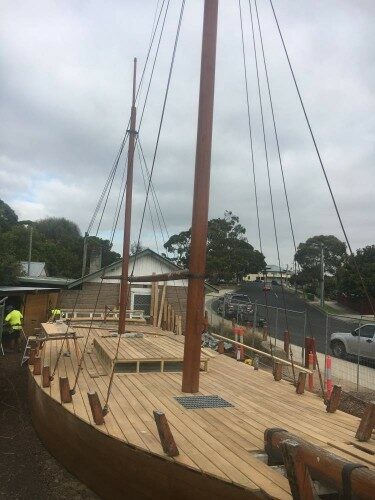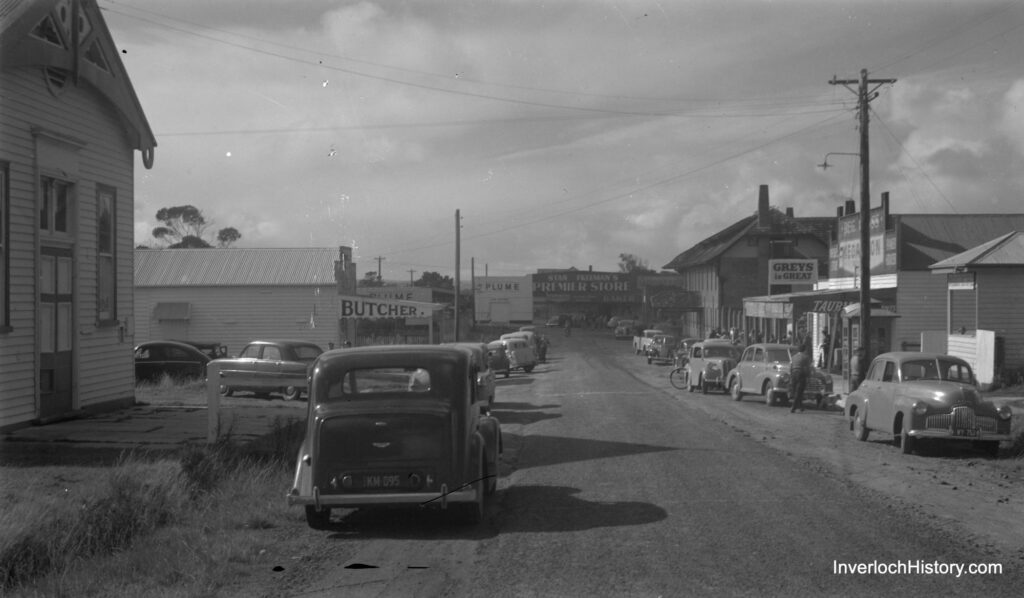Inverloch’s Historical Society & Clock Tower Committee joined forces to create a maritime precinct along the town’s foreshore. The lovingly restored Rocket Shed and replica of The Ripple sit side by side and showcase Inverloch’s connection to the water.
The Ripple is responsible for delivering timber for the first house built in Inverloch and the Rocket Shed tells the story of a time when ocean rescues were less sophisticated than in more recent times.
Rocket Shed
The Rocket Shed, which is one of only three remaining in Victoria, is 115 years old. In the early 1900s, the Rocket Shed housed equipment used to rescue crews from distressed ships along the Inverloch coastline.
Rockets with lines attached were fired to the ships, and then a Breeches Buoy was pulled aboard and used to rescue crew members.
In 2009, the Society received a grant from the Commonwealth Government to restore the Inverloch Rocket Shed.
The Shed has now been restored to Heritage standards.
An Interpretive Display has been placed in the interior.

Coupled with the Replica of the “Ripple” at 22 The Esplanade, Inverloch, the Shed and the Ship form a Maritime Precinct.

The Ripple ketch
The ketch “Ripple” operated in local waters in the late 1880’s and played a big part in the establishing Inverloch as a sea port.
It serviced the area for 40 years, transporting freight & passengers.
Built in 1872, near Gosford, the ketch was 57 feet long and 16 feet wide weighing 29 tons.
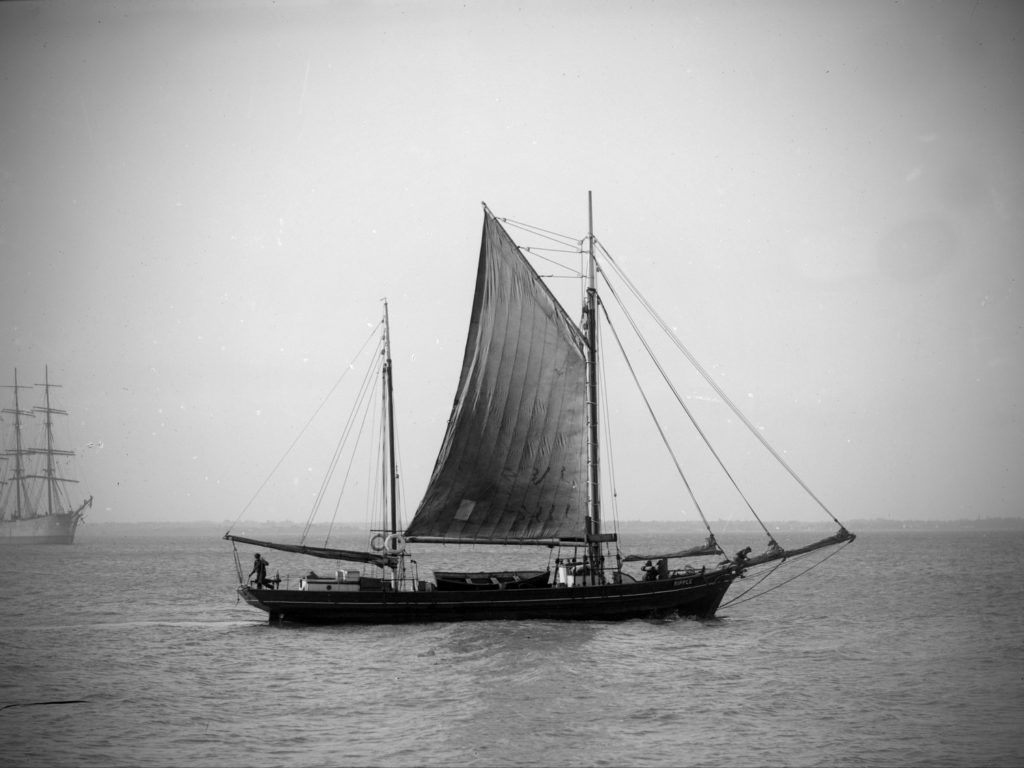
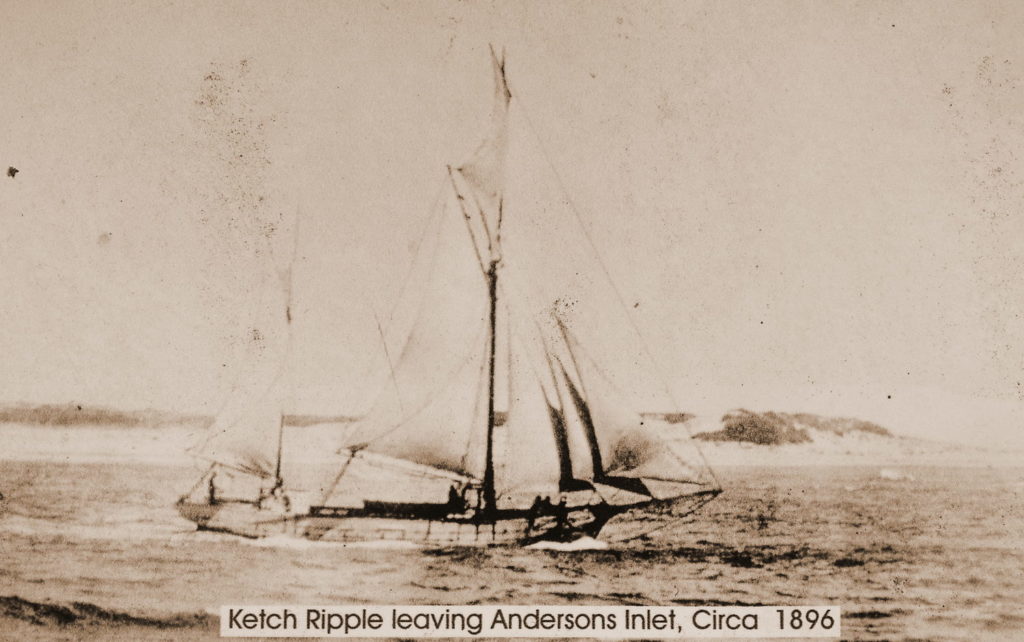
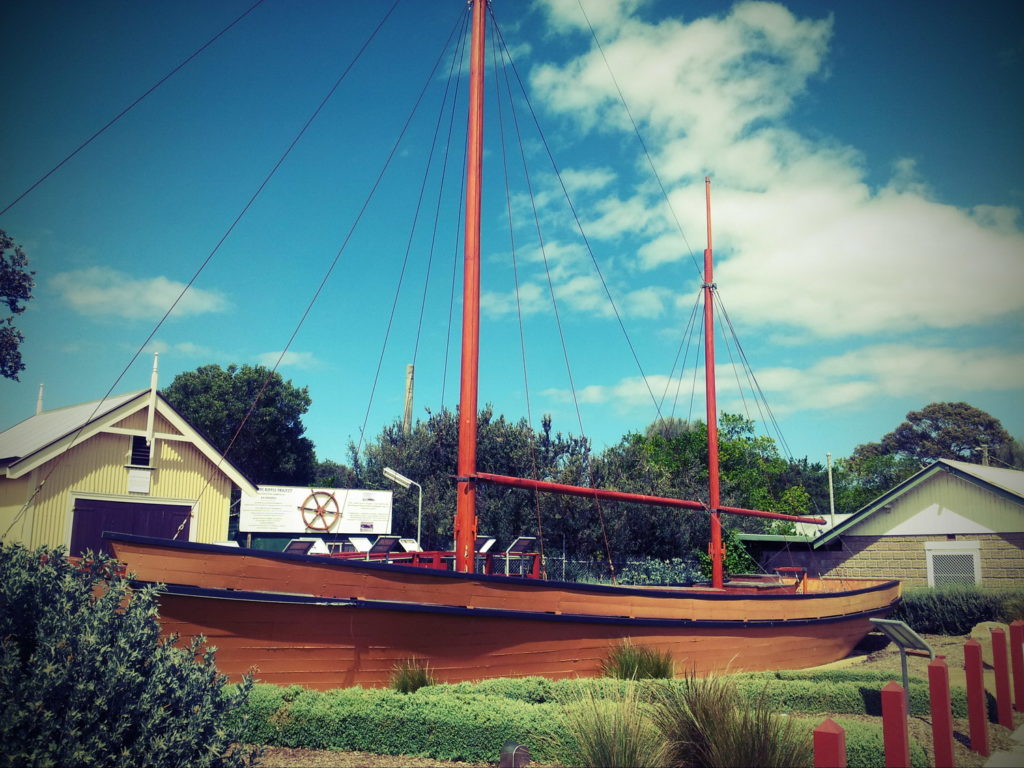
The reproduction of the “Ripple” at Inverloch. The Ripple ketch by the Eaton Family
The Ripple Display Plaques
Updated in 2019 by Bass Coast Shire Council with support from the Inverloch Historical Society.
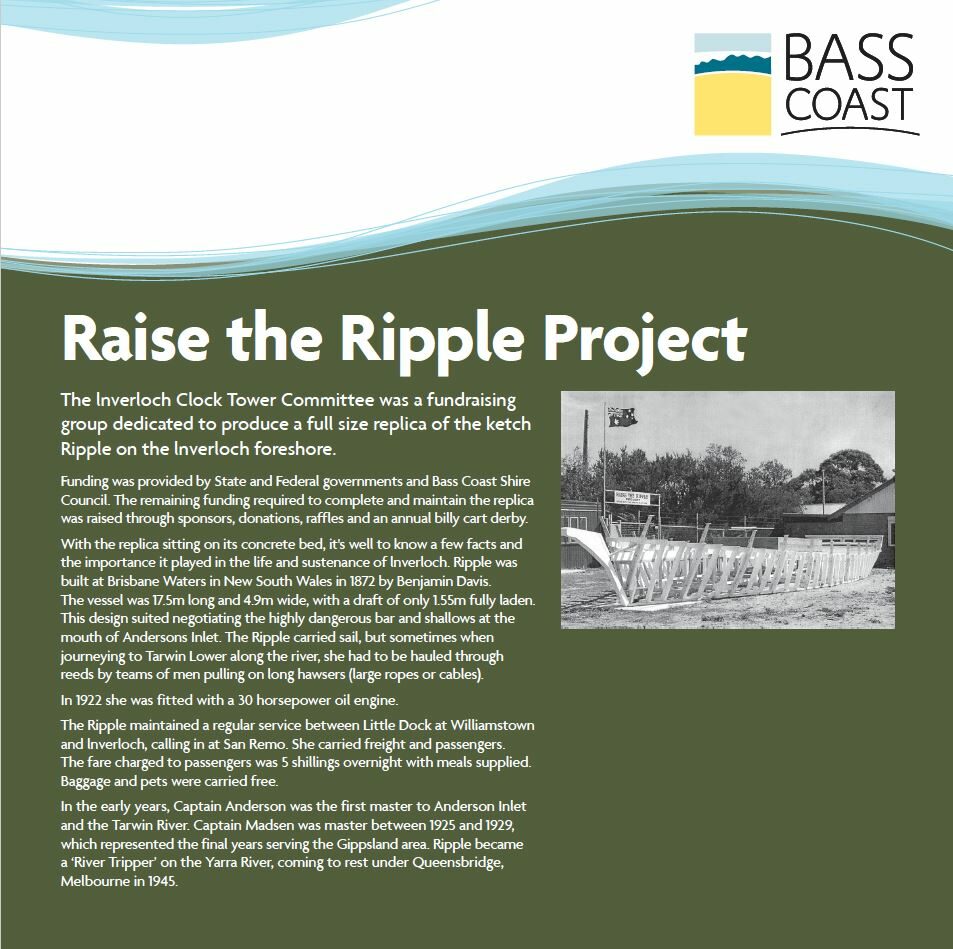
The lnverloch Clock Tower Committee was a fundraising group dedicated to produce a full size replica of the ketch Ripple on the lnverloch foreshore.
Funding was provided by State and Federal governments and Bass Coast Shire Council. The remaining funding required to complete and maintain the replica was raised through sponsors, donations, raffles and an annual billy cart derby.
With the replica sitting on its concrete bed, it’s well to know a few facts and the importance it played in the life and sustenance of lnverloch. Ripple was built at Brisbane Waters in New South Wales in 1872 by Benjamin Davis.
The vessel was 17.5m long and 4.9m wide, with a draft of only 1.55m fully laden. This design suited negotiating the highly dangerous bar and shallows at the mouth of Andersons Inlet. The Ripple carried sail, but sometimes when journeying to Tarwin Lower along the river, she had to be hauled through reeds by teams of men pulling on long hawsers (large ropes or cables).
In 1922 she was fitted with a 30 horsepower oil engine.
The Ripple maintained a regular service between Little Dock at Williamstown and lnverloch, calling in at San Remo. She carried freight and passengers. The fare charged to passengers was 5 shillings overnight with meals supplied. Baggage and pets were carried free.
In the early years, Captain Anderson was the first master to Anderson Inlet and the Tarwin River. Captain Madsen was master between 1925 and 1929, which represented the final years serving the Gippsland area. Ripple became a ‘River Tripper’ on the Yarra River, coming to rest under Queensbridge, Melbourne in 1945.
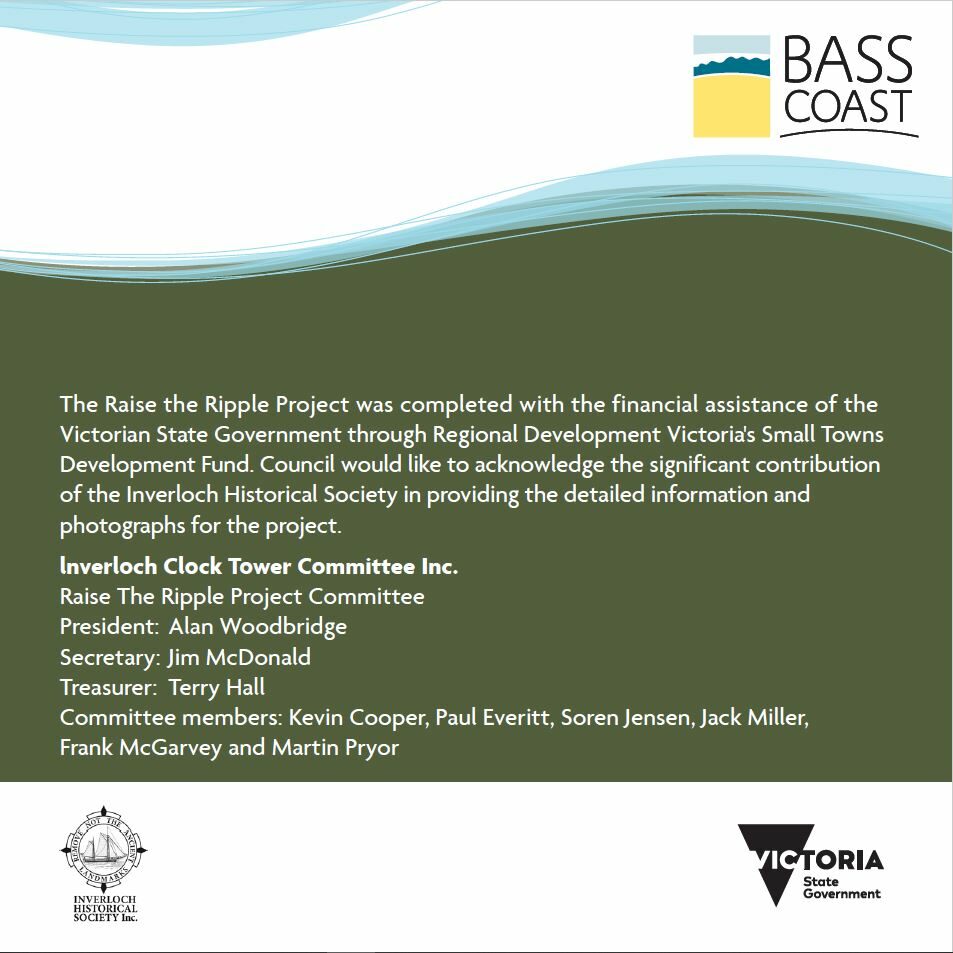
lnverloch Clock Tower Committee Inc.
Raise The Ripple Project Committee
President: Alan Woodbridge
Secretary: Jim McDonald
Treasurer: Terry Hall
Committee members: Kevin Cooper, Paul Everitt, Soren Jensen, Jack Miller, Frank McGarvey and Martin Pryor
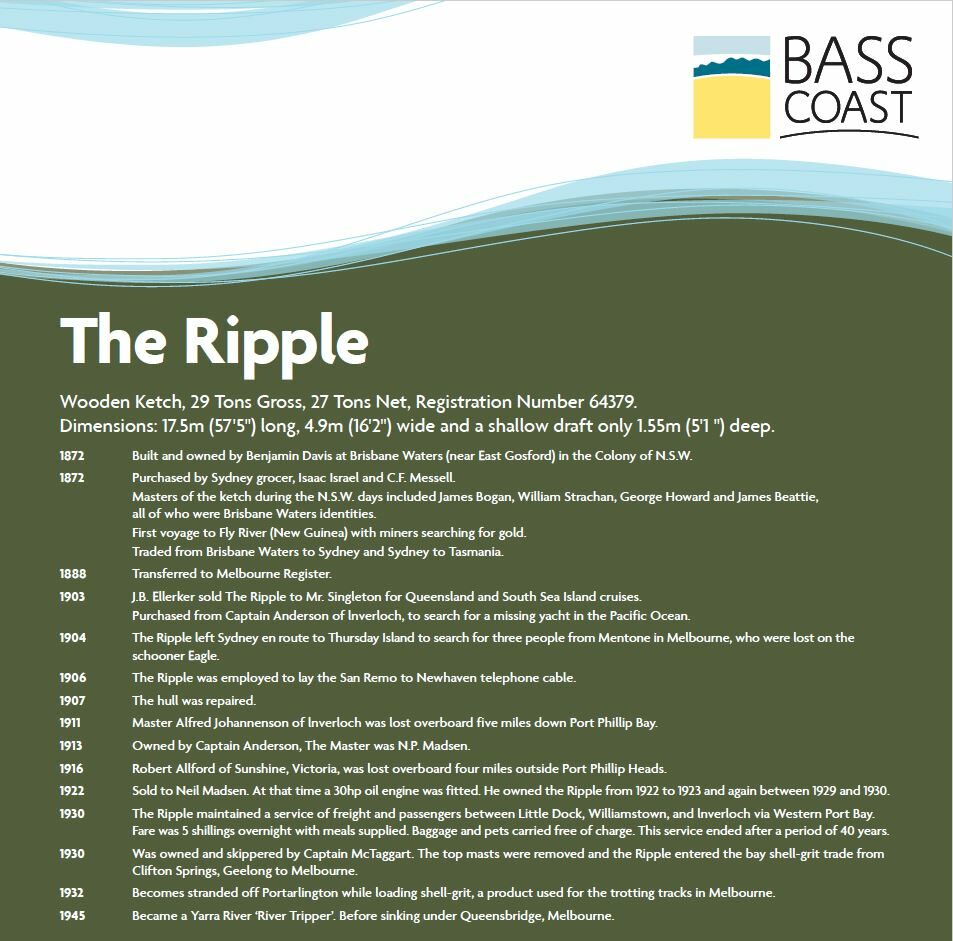
Wooden Ketch, 29 Tons Gross, 27 Tons Net, Registration Number 64379.
Dimensions: 17.5m (57’5″) long, 4.9m (16’2″) wide and a shallow draft only 1.55m (5’1 “) deep.
1872 Built and owned by Benjamin Davis at Brisbane Waters (near East Gosford) in the Colony of N.S.W.
1872 Purchased by Sydney grocer, Isaac Israel and C.F. Messell. Masters of the ketch during the N.S.W. days included James Bogan, William Strachan, George Howard and James Beattie, all of who were Brisbane Waters identities. First voyage to Fly River (New Guinea) with miners searching for gold. Traded from Brisbane Waters to Sydney and Sydney to Tasmania.
1888 Transferred to Melbourne Register.
1903 J.B. Ellerker sold The Ripple to Mr. Singleton for Queensland and South Sea Island cruises.
Purchased from Captain Anderson of lnverloch, to search for a missing yacht in the Pacific Ocean.
1904 The Ripple left Sydney en route to Thursday Island to search for three people from Mentone in Melbourne, who were lost on the schooner Eagle.
1906 The Ripple was employed to lay the San Remo to Newhaven telephone cable.
1907 The hull was repaired.
1911 Master Alfred Johannenson of lnverloch was lost overboard five miles down Port Phillip Bay.
1913 Owned by Captain Anderson, The Master was N.P. Madsen.
1916 Robert Allford of Sunshine, Victoria, was lost overboard four miles outside Port Phillip Heads.
1922 Sold to Neil Madsen. At that time a 30hp oil engine was fitted. He owned the Ripple from 1922 to 1923 and again between 1929 and 1930.
1930 The Ripple maintained a service of freight and passengers between Little Dock, Williamstown, and lnverloch via Western Port Bay. Fare was 5 shillings overnight with meals supplied. Baggage and pets carried free of charge. This service ended after a period of 40 years.
1930 Was owned and skippered by Captain McTaggart. The top masts were removed and the Ripple entered the bay shell-grit trade from Clifton Springs, Geelong to Melbourne.
1932 Becomes stranded off Portarlington while loading shell-grit, a product used for the trotting tracks in Melbourne.
1945 Became a Yarra River ‘River Tripper’. Before sinking under Queensbridge, Melbourne.
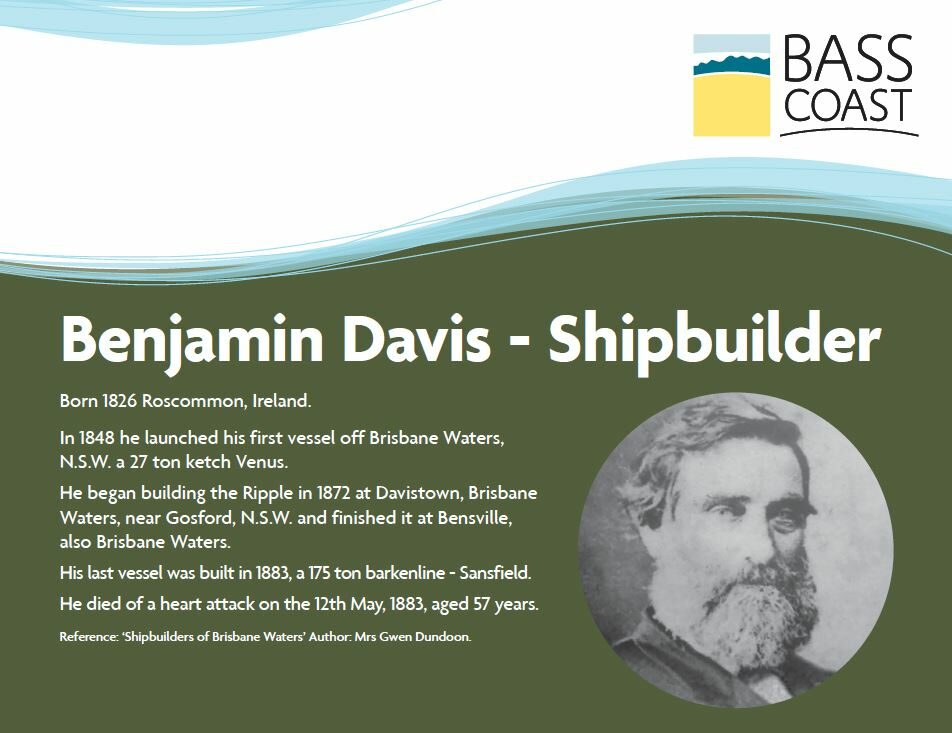
Born 1826 Roscommon, Ireland.
In 1848 he launched his first vessel off Brisbane Waters,
N.S.W. a 27 ton ketch Venus.
He began building the Ripple in 1872 at Davistown, Brisbane
Waters, near Gosford, N.S.W. and finished it at Bensville,
also Brisbane Waters.
His last vessel was built in 1883, a 175 ton barkenline – Sansfield.
He died of a heart attack on the 12th May, 1883, aged 57 years.
Reference: ‘Shipbuilders of Brisbane Waters’ Author: Mrs Gwen Dundoon.
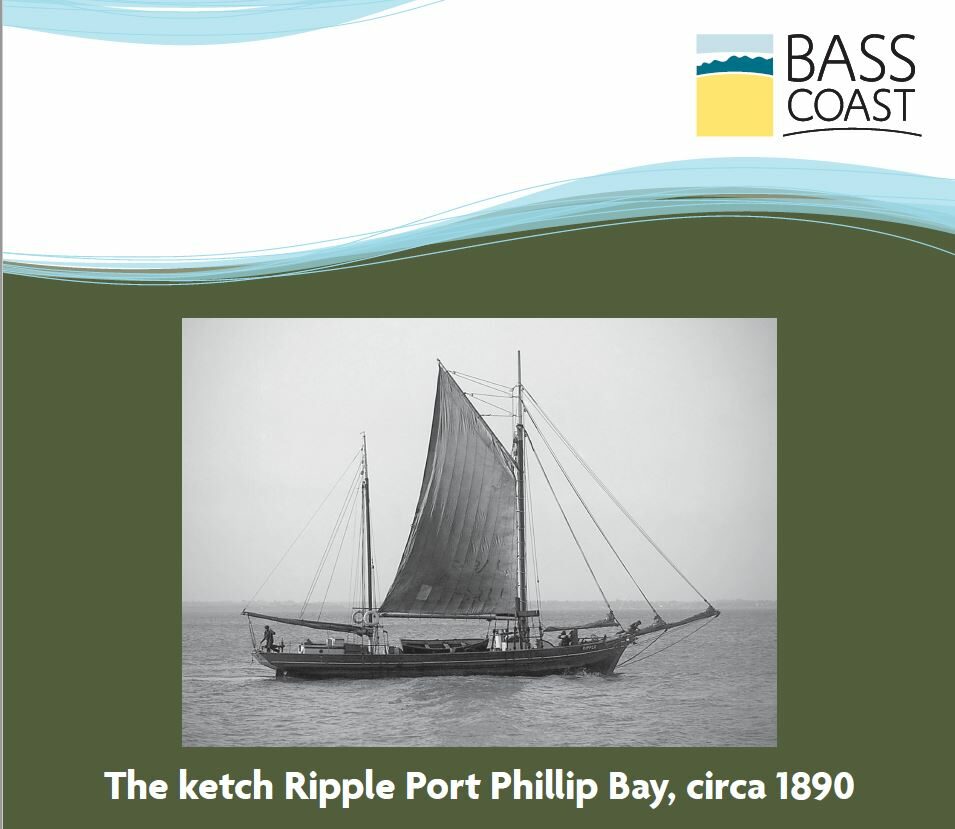
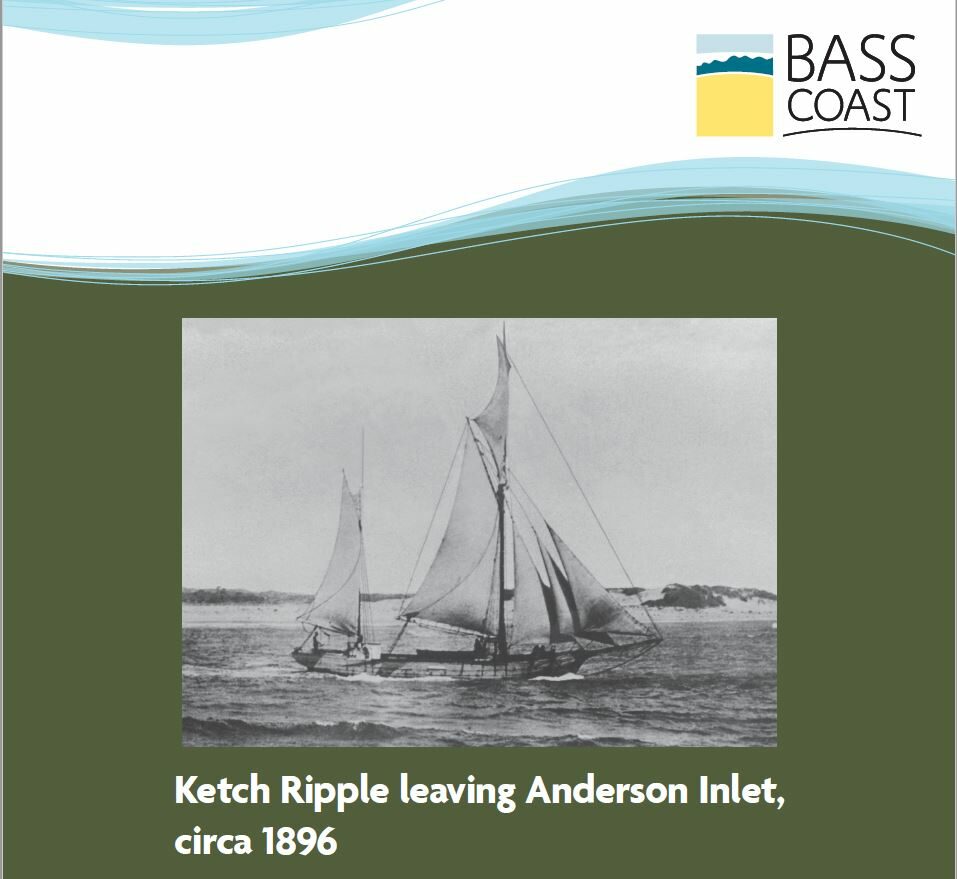
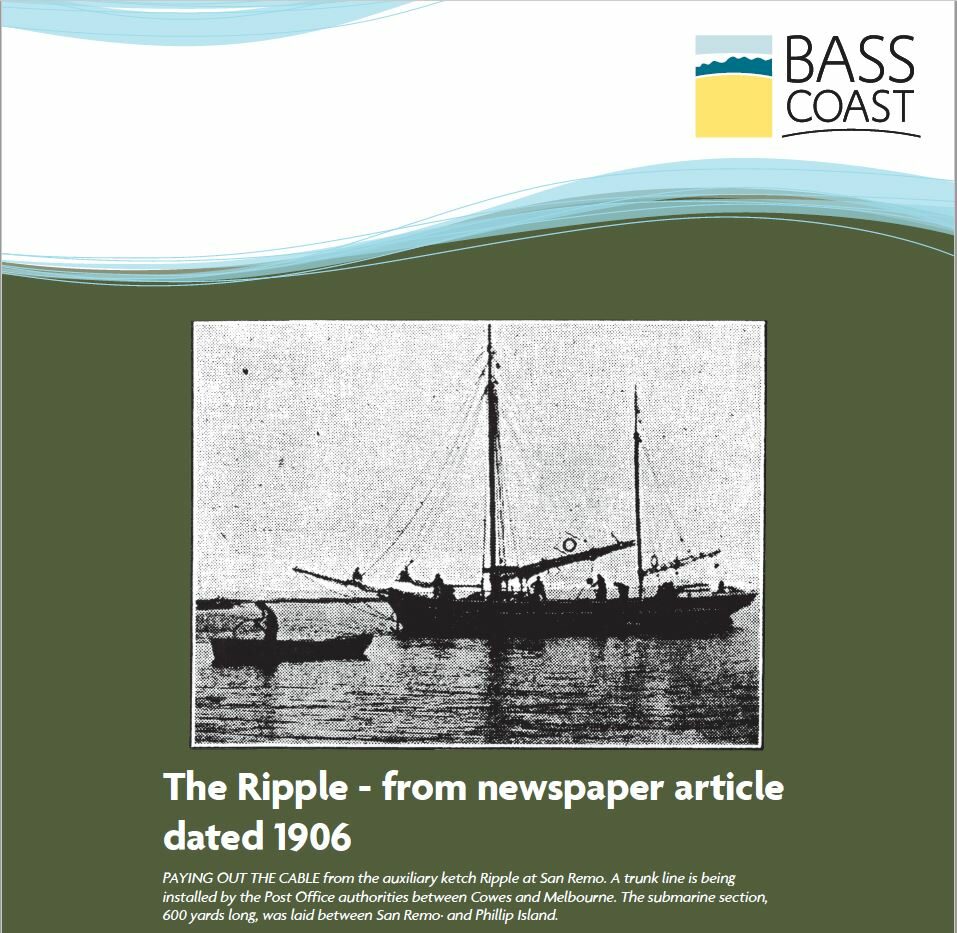
PAYING OUT THE CABLE from the auxiliary ketch Ripple at San Remo. A trunk line is being
installed by the Post Office authorities between Cowes and Melbourne. The submarine section,
600 yards long, was laid between San Remo· and Phillip Island.
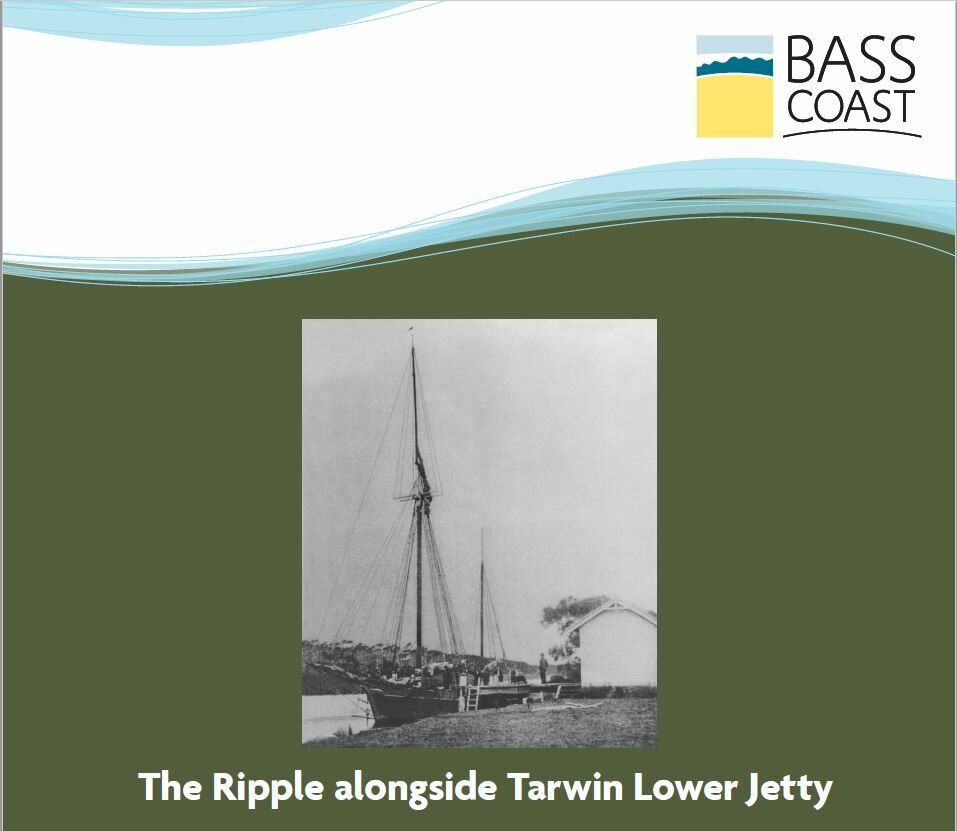
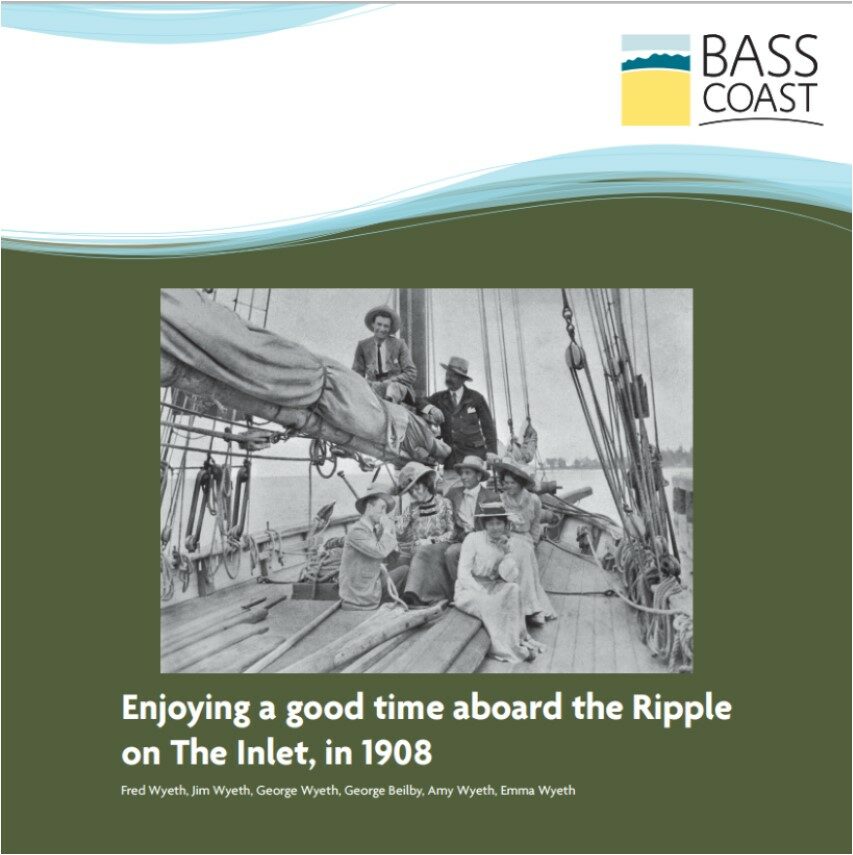
Fred Wyeth, Jim Wyeth, George Wyeth, George Beilby, Amy Wyeth, Emma Wyeth
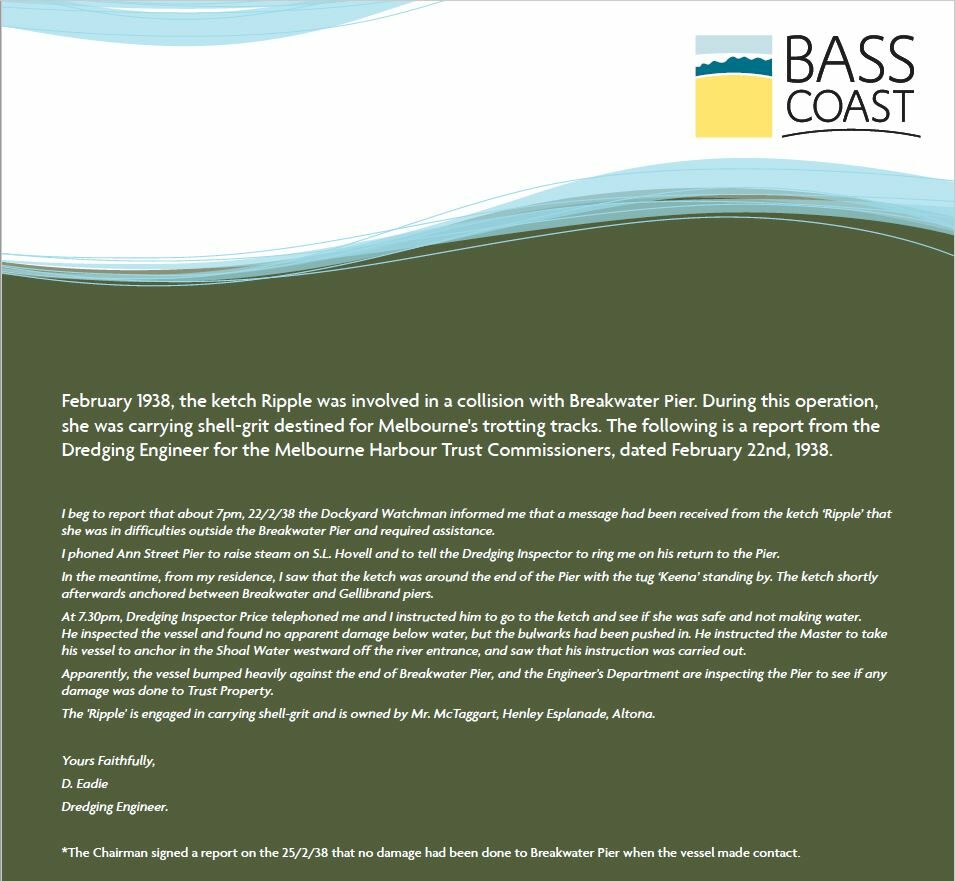
she was carrying shell-grit destined for Melbourne’s trotting tracks. The following is a report from the
Dredging Engineer for the Melbourne Harbour Trust Commissioners, dated February 22nd, 1938.
beg to report that about 7pm, 22/2/38 the Dockyard Watchman informed me that a message had been received from the ketch ‘Ripple’ that she was in difficulties outside the Breakwater Pier and required assistance.
I phoned Ann Street Pier to raise steam on S.L. Hovell and to tell the Dredging Inspector to ring me on his return to the Pier.
In the meantime, from my residence, I saw that the ketch was around the end of the Pier with the tug ‘Keena’ standing by. The ketch shortly afterwards anchored between Breakwater and Gellibrand piers.
At 7.30pm, Dredging Inspector Price telephoned me and I instructed him to go to the ketch and see if she was safe and not making water.
He inspected the vessel and found no apparent damage below water, but the bulwarks had been pushed in. He instructed the Master to take his vessel to anchor in the Shoal Water westward off the river entrance, and saw that his instruction was carried out.
Apparently, the vessel bumped heavily against the end of Breakwater Pier, and the Engineer’s Department are inspecting the Pier to see if any damage was done to Trust Property.
The ‘Ripple’ is engaged in carrying shell-grit and is owned by Mr. McTaggart, Henley Esplanade, Altona.
Yours Faithfully,
D. Eadie, Dredging Engineer.
*The Chairman signed a report on the 25/2/38 that no damage had been done to Breakwater Pier when the vessel made contact.

The old horses, with their feed bags over their heads, munched away whilst the drivers, dressed in flannels and long trousers, worked like demons, lumping bags of cereal as well as just about every other type of merchandise imaginable on their backs. They loaded and unloaded their drays to the rattle of winches
and tackle. There were no cranes and no forklifts then, nor were there too many tea breaks.
Perhaps with a heavy attack of nostalgia, you may even imagine that you can smell smoke from the dozens of fussy little steam engines shunting to and fro over the viaduct, adding their own pollution to that of several steamers nearby, which were flashing up in readiness for sea.
Little piles of chaff and horse manure could be seen wherever the wind saw fit to leave them, and the gutters were continually aflow where the old horses pumped ship whilst awaiting their drivers commands.
At the commencement of the 1930s, there was a number of small sail trading vessels operating in Port Phillip Bay. These were the shell-grit carriers, the ketches Ripple, Helen Moore, Speedwell, Tangalooma and the schooner Woolamai. There was also a 20 tonne converted fishing boat, officially known by its registration number only, but affectionately called ‘Paddy’ by its owner.
These ships were decrepit old warriors with patched sails and stained decks, owned and worked on in the meanest fashion. The last of a proud fleet of small sailors that once crossed the bay in great numbers.
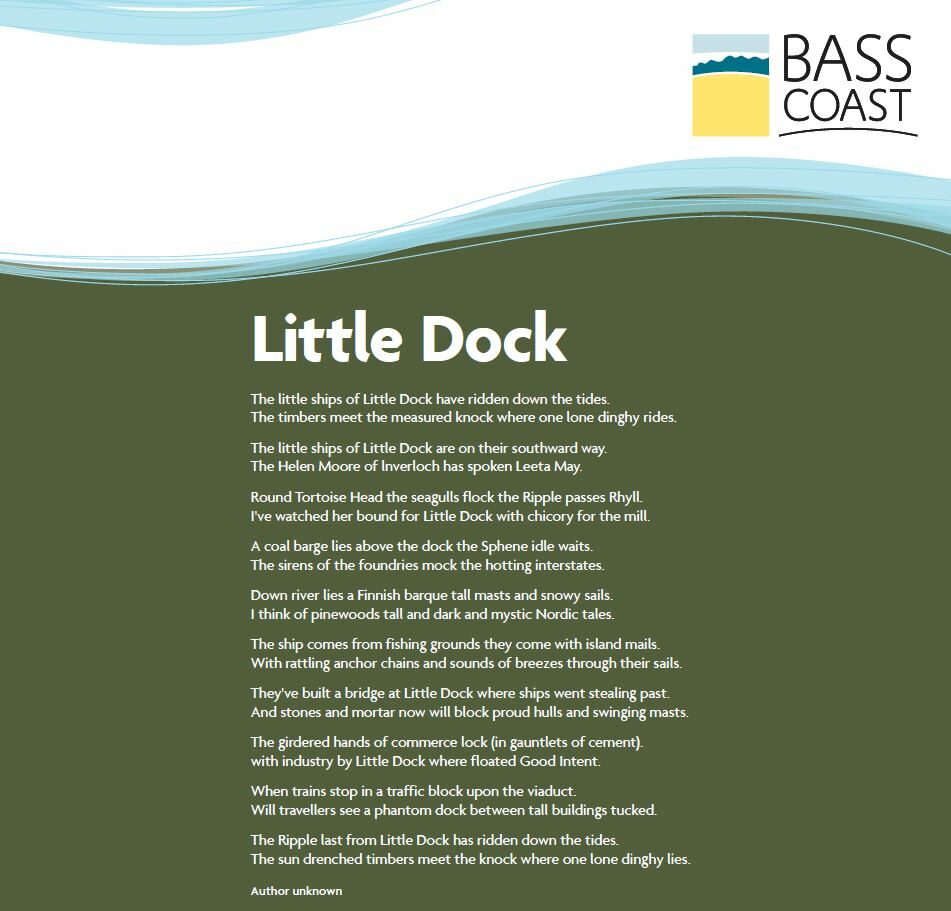
The timbers meet the measured knock where one lone dinghy rides.
The little ships of Little Dock are on their southward way.
The Helen Moore of lnverloch has spoken Leeta May.
Round Tortoise Head the seagulls flock the Ripple passes Rhyll.
I’ve watched her bound for Little Dock with chicory for the mill.
A coal barge lies above the dock the Sphene idle waits.
The sirens of the foundries mock the hotting interstates.
Down river lies a Finnish barque tall masts and snowy sails.
I think of pinewoods tall and dark and mystic Nordic tales.
The ship comes from fishing grounds they come with island mails.
With rattling anchor chains and sounds of breezes through their sails.
They’ve built a bridge at Little Dock where ships went stealing past.
And stones and mortar now will block proud hulls and swinging masts.
The girdered hands of commerce lock (in gauntlets of cement).
with industry by Little Dock where floated Good Intent.
When trains stop in a traffic block upon the viaduct.
Will travellers see a phantom dock between tall buildings tucked.
The Ripple last from Little Dock has ridden down the tides.
The sun drenched timbers meet the knock where one lone dinghy lies.
Author unknown
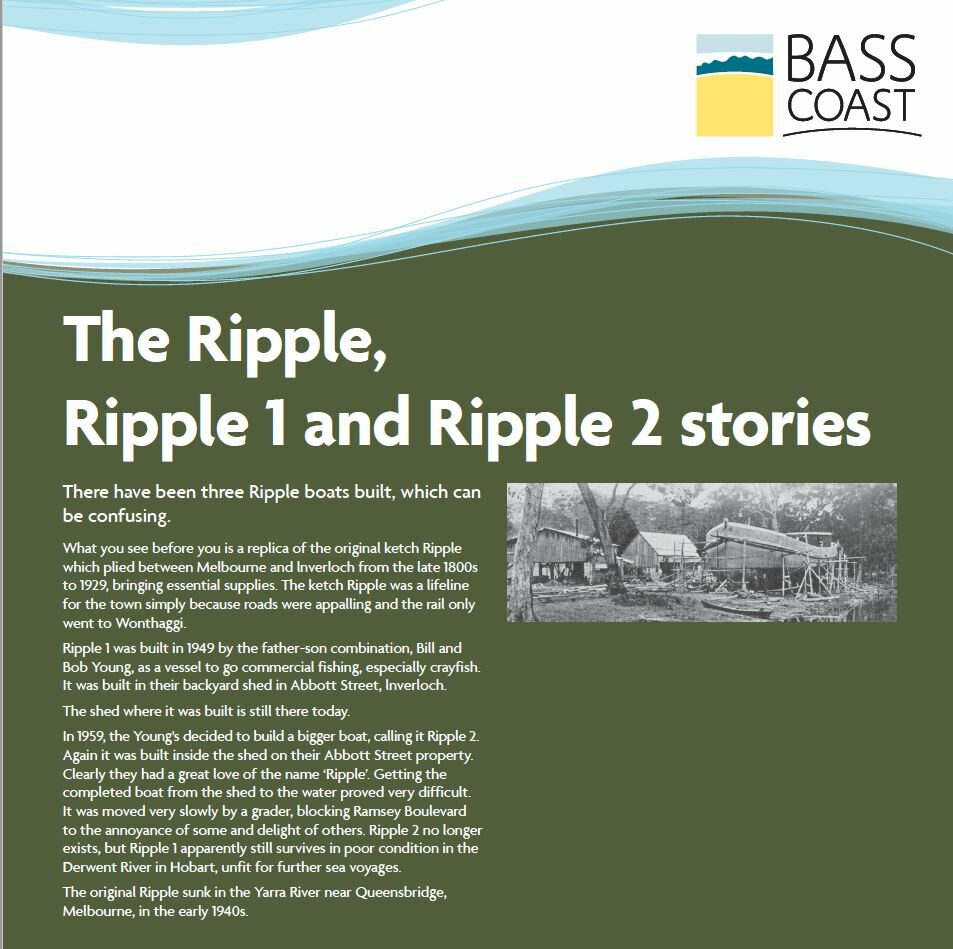
There have been three Ripple boats built, which can be confusing.
What you see before you is a replica of the original ketch Ripple which plied between Melbourne and lnverloch from the late 1800s to 1929, bringing essential supplies. The ketch Ripple was a lifeline for the town simply because roads were appalling and the rail only went to Wonthaggi.
Ripple 1 was built in 1949 by the father-son combination, Bill and Bob Young, as a vessel to go commercial fishing, especially crayfish. It was built in their backyard shed in Abbott Street, lnverloch.
The shed where it was built is still there today.
In 1959, the Young’s decided to build a bigger boat, calling it Ripple 2. Again it was built inside the shed on their Abbott Street property. Clearly they had a great love of the name ‘Ripple’. Getting the completed boat from the shed to the water proved very difficult. It was moved very slowly by a grader, blocking Ramsey Boulevard to the annoyance of some and delight of others. Ripple 2 no longer exists, but Ripple 1 apparently still survives in poor condition in the Derwent River in Hobart, unfit for further sea voyages.
The original Ripple sunk in the Yarra River near Queensbridge, Melbourne, in the early 1940s.

Will (Bill) Young was born in Northhampton, England, in 1891. He spent his early life in sailing ships, travelling the world around the infamous Cape Horn. In 1911, he jumped ship when in Melbourne. He then served with the 6th, Battalion in Egypt and France during World War I. During this time he wrote a vivid war diary which is now in the National War Memorial, Canberra. He ran a little engineering machine
shop near Princes Bridge, Melbourne, for seven years. The depression hit him hard, but having purchased a block of land in lnverloch in 1925, he decided to move there and build his own house. He took up crayfishing which he described as ‘an excellent paying game’ providing one had a suitably well fitted out boat and good gear. During World War II he worked in engineering in Melbourne, but then returned to
lnverloch. In 1949 with his son Bob, they built Ripple 1. Ripple 2 commenced in 1959 and took two years to complete. Both boats were built in a shed in their backyard in Abbott Street, which still exists. They were large boats, ready for commercial crayfishing in Bass Strait and Tasmanian island waters, which suited the Youngs well. Bob spent 40 years as a cray-fisherman.
Respect for the original Ripple influenced their decision to call both their boats Ripple.
Both Will and Bob were involved in numerous rescues in Bass Strait and Anderson Inlet, often at great risk to themselves. They received commendations from the government and police. Their public and community service has always been valued by the lnverloch and Victorian community.

The Bass Coast Shire Council support this major project.
The Ripple replica undergoes a re-birth!
In early 2018, Bass Coast Shire Council undertook a major renovation of Inverloch’s much-loved replica of “The Ripple” as part of the Council’s 2017/18 Renewal Program.
The replica of The Ripple was originally built by Inverloch’s Clock Tower Committee and Historical Society as a reminder of Inverloch’s connection to the coast.
Bass Coast Mayor, Cr Pamela Rothfield, says “The Ripple is a significant monument for the Inverloch community.
The project acknowledges the historical significance of The Ripple, launched from Inverloch over 100 years ago,” she said.
The Ripple underwent a full rebirth, with major framing, ventilation, cladding and decking works done.
